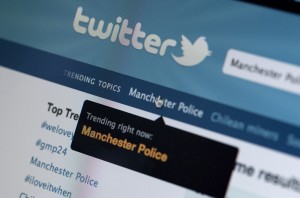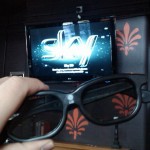Episode 2. Here be spoilers. I will start by saying that I was genuinely frightened by this episode; watching with the curtains closed. “Nothing can physically harm you”, intones character Katie to our protagonist Cooper, an American man travelling the world to escape problems at home. But she can’t know that, not for certain. Accidents happen. The simple power of being alone in the dark working against every rational instinct you have that everything’s fine really is deployed here superbly. Skipping over the finer plot details, when the plot twist is revealed, it’s good. But there’s more; this is no Bobby Ewing in the shower moment. Reality falls away as we realise we’ve been duped more than once along the way here. I foresee irritation on the part of some viewers, but with clarity perhaps a grudging admiration might develop. It’s where I am now.
TV review: Nosedive (Black Mirror)
So it’s here. Netflix gives us Charlie Brooker’s glimpses into the near future – one exception – in all-new BLACK MIRROR, the first episodes since the 2014 feature-length special.
NOSEDIVE
When Netflix announced it had commissioned twelve new episodes, the Twittersphere leapt in to action and groupthought the notion that the show, a gritty piece of navel-gazing exposé, would become “Americanised”, with all the Trump-electing horror that could bring. I report that this is not the case. The team of writer Charlie Brooker and executive producer Annabel Jones, a longtime collaborator with fine results, endures with excellent results.
NOSEDIVE is, however, set in America. So far, it seems to me to be set the closest to the present day of all the previous episodes. There are electric cars but they’re not driverless. People still hold mobile phones; they aren’t embedded under our skin. People use video calling rather than teleportation or holograms. It’s very now.
The premise is simple. A world in which everyone’s social status is proclaimed to the world via an app. People rank each other after every social interaction with a Tinder-style one to five star rating system. So far, so recognisable.
I’m not one to proclaim the downfall of civilisation because people are rating one another’s’ attractiveness with apps. But the story takes this modern day scenario further. There are implications to having a low rating – protagonist Lacie (Bryce Dallas Howard) can’t board an important flight or rent a classy apartment due to unfortunate circumstances lowering her ranking. It would be easy and perhaps even expected in other programmes for there to be a simple crash and burn end for Lacie, but in typical BLACK MIRROR style, there’s more. She meets a truck driver while hitchhiking who has an even lower rating than Lacie. She’s opted out of the system after realising it’s meaningless and that actual interaction is what counts, not swipes and likes. It’s the closest BLACK MIRROR has come to passing a moral judgement on our always-imminent high-tech future. Interestingly, it wasn’t actually written by Brooker. The teleplay comes from Mike Schur and Rashida Jones, based on an idea by Brooker.
Things come to a head when Lacie’s ranking reaches zero after she breaks down at her best friend’s wedding. Uninvited whilst hitchhiking en route, she tries to attack the groom after making a speech which the elite ranking guests don’t like. In prison, the Google Glass-style implanted device in her eyes which assists with the rating is removed, leaving her free to behave how she wishes without fear. She can’t go lower. Where next? A sequel, perhaps? Time will tell.
Police in Twitter experiment
 A police force in England has made a splash in the social media world by tweeting every incident it dealt with over a 24 hour period from 5AM BST (midnight EST) on Thursday October 14th to the same time yesterday, Friday 15th.
A police force in England has made a splash in the social media world by tweeting every incident it dealt with over a 24 hour period from 5AM BST (midnight EST) on Thursday October 14th to the same time yesterday, Friday 15th.
Greater Manchester Police decided to open up their operations for the day to show the public exactly what its officers do, and to demonstrate to the government how damaging proposed cuts to funding and staff would be.
The force used four different accounts because of Twitter’s spam-reducing tweet frequency limit to detail a total of 3,205 incidents. 341 people were arrested over the 24 hour period, and 126 of those remained in custody by the end of the 24 hours the force was tweeting for. The experiment received wide-ranging praise from across the world, with the hashtag used in each tweet, “#gmp24” becoming the most-mentioned phrase worldwide on the site.
The calls reported varied from serious incidents like possible domestic violence to more trivial matters like a nuisance call about a trapped cat and reports of loud music being played.
It wasn’t long before hundreds of people started following the police’s activity, with many retweets spreading the word of what the force was doing across Twitter and the web. A spoof account was quickly created by some witty chancer, while the main @gmpolice account gained thousands of new followers.
Greater Manchester Police is hailing the experiment as a success. The force’s Chief Constable Peter Fahy was fully behind the idea, and afterwards spoke about what it achieved.
He said: “The reaction we have received proves that the public perception of modern day policing was removed from the reality that my officers face.
“As well as serious crimes, we deal with many social issues and other incidents that the public are quite surprised about.”
Using social media tools available to everyone, like Twitter, is a great way of drawing the attention of the mass media to things that might otherwise go unnoticed. In the last year, simple hashtags have been used to whip up support for several things threatened in the UK, including “#welovetheNHS” and “#proudoftheBBC”, which was just today turned in to a song by popular comedian and singer-songwriter Mitch Benn. Enjoy it below, and you can see all the tweets by GMP here.
Image © Copyright Greater Manchester Police. All rights reserved.
3D TV – must-have gadget or modern gimmick?
 3D TV is the latest idea to move out of the lab and in to the home. At the beginning of this month, Rupert Murdoch’s Sky TV launched Europe’s first 3D television channel, showing 14 hours of content daily. So far this has been selected films and Premiership football matches, following on from trials of the service in pubs across Britain.
3D TV is the latest idea to move out of the lab and in to the home. At the beginning of this month, Rupert Murdoch’s Sky TV launched Europe’s first 3D television channel, showing 14 hours of content daily. So far this has been selected films and Premiership football matches, following on from trials of the service in pubs across Britain.
Just like when you see a 3D film at the cinema, you need to wear special glasses. But gone are the plastic blue and red specs you pay more for at the flicks. The new generation of 3D TV uses sleek, futuristic-looking glasses. They’re not cheap, at around £100 ($158) a pair, but are of course more sturdy and reliable. The old glasses will still let you see in three dimensions, just not as well.
However, the cinema is a place where, over the last few years, people have become accustomed to picking up a pair, sitting down to watch the film and looking a bit silly. The living room is a whole new arena – are people ready to adapt?
Where is the market for non-fictional 3D content on TV? I’ve seen one or two films marketed as “3D”. One was Coraline, Henry Selick’s computer-animated adaptation of the Neil Gaiman novel. I remember a few things seemingly coming out of the screen towards me, which I presume is scary for children. But is it entertaining? Does it add anything to the plot, or is it just a gimmick? I think the latter. Warner Brothers announced last week that the planned 3D release of Harry Potter and the Deathly Hallows Part One had been cancelled as the studio was unable to ready it in time for the November release. As such, the film will only be seen in cinemas in 2D. Part Two, to be released in July next year, will also be in 3D.
I cannot see 3D being employed as a serious tool by, for example, news broadcasters, talk shows, comedy programmes or any drama series. It would ruin the feel of the programme by figuratively and, literally via technology, breaking the fourth wall.
Then there is the actual capability to view the programmes. For this, a TV with the necessary hardware built-in is required. Many people have forked out for expensive high definition televisions, and these are just now becoming the new standard available in shops. Consumers set them up to find that the quality on a small selection of programmes is only marginally better. It will be some years before HD becomes standard on the majority of television output, and surely many more years later before 3D is so – if it ever takes off properly.
Also this month, the first hardware supporting Google’s upcoming TV offering will become available, with Logitech’s Revue set to ship on October 21st and offerings from Sony and other companies debuting later this year or in early 2010. Apple also started selling its relaunched Apple TV box, first shown in September.
It seems there is a future in television, despite what the online future media nay-sayers might claim. But the content and format is certain to be very different to that seen today.
Image by user pcs007 on Flickr, used under a CC-BY-SA license.
We love it, yeah, yeah, yeah!
This is good news, and this is even better.
If it’s too much effort to click on two links, I’ll summarise: EMI have announced all their music available digitally will soon be DRM-free. Added to this catalogue will soon be the music of the Fab Four – The Beatles. Excellent!
